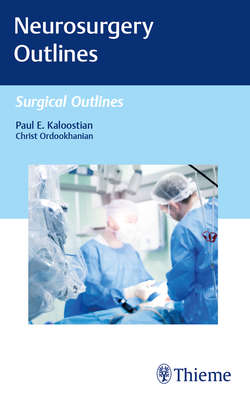Читать книгу Neurosurgery Outlines - Paul E. Kaloostian - Страница 98
На сайте Литреса книга снята с продажи.
Surgical Procedure for Posterior Thoracic Spine
Оглавление1. Informed consent signed, preoperative labs normal, no Aspirin/Plavix/Coumadin/NSAIDs/Celebrex/Naprosyn/other anticoagulants and anti-inflammatory drugs for at least 2 weeks
2. Appropriate intubation and sedation and lines (if necessary) as per the anesthetist
3. Patient placed prone on Jackson Table with all pressure points padded
4. Neuromonitoring may be required to monitor nerves
5. Time out is performed with agreement from everyone in the room for correct patient and correct surgery with consent signed
6. Make an incision down the midline of back
7. Perform subperiosteal dissection of muscles bilaterally exposing the spinous process and paraspinal muscles
8. Dissect tissue planes along spinous process and laminae using rongeurs
9. Move paraspinal muscles laterally to expose the laminae
10. Once the locus of interest is exposed, it is best to localize and verify the correct vertebra via X-ray or fluoroscopic imaging and confirming with at least two people in the room
11. Perform the decompression procedure over the desired segments based on preoperative imaging of levels that are compressed due to trauma (see ▶Fig. 2.11 to Fig. 2.14):
a. Using Leksell rongeurs and hand-held high-speed drill, remove the bony spinous process and bilateral lamina as indicated for specific procedure (laminectomy)
b. Or, remove bone of lamina above and below spinal nerves to create a small opening of lamina, relieving compression (laminotomy)
Fig. 2.11 A middle-aged woman with a dorsal epidural lesion in T3–T8 and cord compression (a) received left T3–T5 hemilaminotomies and right T6–T8 hemilaminotomies, resecting the lesion (b). Follow-up MRI (1 year) demonstrates neither recurrence of lesion nor kyphosis (c). (Source: Minimally invasive thoracic decompression for multilevel thoracic pathology. In: Fessler R, Sekhar L, eds. Atlas of Neurosurgical Techniques: Spine and Peripheral Nerves. 2nd ed. Thieme; 2016).
Fig. 2.12 Intraoperative image demonstrating positioning of retractors for multilevel thoracic pathology. The retractors are expanded in the rostral–caudal direction. This is followed by electrocautery to visualize the lamina and achieve decompression. (Source: Minimally invasive thoracic decompression for multilevel thoracic pathology. In: Fessler R, Sekhar L, eds. Atlas of Neurosurgical Techniques: Spine and Peripheral Nerves. 2nd ed. Thieme; 2016).
Fig. 2.13 Image demonstrating relevant anatomy to thoracic outlet decompression. This anatomy is visualized after the anterior and middle scalene is divided, decompressing the brachial plexus. (Source: Authors’ preferred technique. In: Mackinnon S, ed. Nerve Surgery. 1st ed. Thieme; 2015).
Fig. 2.14 Postoperative MRI of thoracic reveals proper decompression of cord and spinal canal following a thoracoscopic diskectomy (a). Postoperative CT scan of thoracic reveals bony resection achieved during diskectomy (b). (Source: Technique for thoracoscopic diskectomy. In: Kim D, Choi G, Lee S, et al, eds. Endoscopic Spine Surgery. 2nd ed. Thieme; 2018).
c. Remove the thick ligamentum flavum and any bone spurs with Kerrison rongeurs with careful dissection beneath the ligament to ensure no adhesions exist to dura mater below and thus avoiding CSF leak
d. Perform appropriate foraminotomy with Kerrison rongeurs as needed for appropriate decompression of nerve roots
12. Perform spinal fusion with instrumentation:
a. Place pedicle screws over two segments above and two segments below the problem level involved with connecting rods bilaterally, in addition to bone grafting, to fuse these segments
13. After appropriate hemostasis is obtained, muscle and skin incisions can then be closed in appropriate fashion, often with placement of postoperative drains that can be removed after 2 to 3 days
